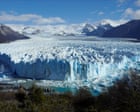
In recent months, different corners of our planet have faced unique environmental challenges, drawing attention to the intricate balance of nature and our role in it. From the majestic ice fields of Patagonia to the picturesque beauty of northern Italy, and the serene landscapes of England and the Grand Canyon, each region experiences its own set of hurdles as we navigate a rapidly changing climate.
In the southern reaches of Argentina, the Perito Moreno Glacier, long celebrated as one of the few stable glaciers amidst a world increasingly marked by melt, is now sadly joining the trend of glacial decline. Spanning the picturesque Santa Cruz province, this once-stalwart expanse of ice has shown worrying signs of retreat. Over the past seven years, Perito Moreno has lost an alarming 1.92 square kilometers of ice cover, with its thickness diminishing by up to eight meters annually. Scientists express concerns about the longevity of this once-stable giant, as it appears increasingly susceptible to rising temperatures.
Meanwhile, in the serene farmlands of Ferrara province, north-eastern Italy, local farmers are confronted with an unexpected visitor that’s disrupting their time-honored traditions. Flamingos have taken to the flooded paddy fields that are ideal for risotto rice cultivation, stirring the soil in a manner that harms upcoming crops. These graceful birds, new arrivals to the area, have made themselves at home, piquing the interest of the agricultural community. Efforts are being made to find harmonious ways to address these avian intrusions, with farmers hoping to balance their needs against the natural patterns of these migratory birds.
In England, the dry spell is causing another type of challenge as the country faces its lowest reservoir levels in a decade. Currently, reservoirs are filled to only 76% capacity, even lower than during the severe drought of 2022. In light of this situation, experts are urging water companies to introduce hosepipe bans to conserve water. Such measures aim to encourage mindful consumption and assure water availability during these dry periods, highlighting the importance of proactive management in the face of climate irregularities.
Lastly, across the Atlantic, the Grand Canyon, a symbol of raw natural beauty, is grappling with a fast-spreading fire that has necessitated the evacuation of hundreds of tourists. Originating near the iconic park’s northern rim, the fire has proven difficult to control, sending plumes across the horizon and requiring swift action from park authorities to ensure visitor safety. This incident serves as a poignant reminder of the vulnerabilities that even the most enduring landscapes can face.
As we observe these occurrences unfold across continents, there lies an imperative to engage with these changes mindfully. They invite us to ponder the interconnectedness of our actions and the environment, urging us towards sustainable stewardship and thoughtful adaptation. Each event—whether a retreating glacier, curious flamingos, parched reservoirs, or advancing flames—offers an opportunity for reflection and responsible action as part of a global community committed to maintaining nature’s balance.
Source: {link}
